- Home
- Jean M. Auel
THE PLAINS OF PASSAGE ec-4 Page 5
THE PLAINS OF PASSAGE ec-4 Read online
Page 5
As though they had mutually decided to stop and eat, it was quiet for a while, with all the mammoths moving slowly south through the tallgrass tearing out trunkful after trunkful in a steady rhythm. In the rare moment of relief from the harassment of the males, the chestnut mammoth stood with her head low, looking very tired as she tried to feed.
Mammoths spent most of the day, and night, eating. Though it could be of the roughest, poorest quality – they could even eat shreds of bark torn off with tusks, though that was more often winter feed – mammoths needed huge quantities of the fibrous fare to sustain them. Included in the several hundred pounds of roughage consumed every day, which they passed through their bodies within twelve hours, was a small, though necessary, addition of succulent, broad-leaved, more nutritious plants, or occasionally a few choice leaves of willow, birch, or alder trees, higher in food value than the coarse tallgrass and sedge, but toxic to mammoths in large quantities.
When the great woolly beasts had moved some distance away, Ayla tied the restraining rope on the young wolf, who was if anything even more interested than they were. He kept wanting to get closer, but she didn't want him to disturb the herd or annoy them. Ayla felt the matriarch had given them leave to stay, but only if they kept their distance. Leading the horses, who were exhibiting some nervousness and excitement as well, they circled around through the tallgrass and followed the herd. Though they had been watching for some time, neither Ayla nor Jondalar was inclined to leave yet. There was still a sense of anticipation lingering around the mammoths. Something was coming. Perhaps it was just that the mating they felt privileged, almost invited, to observe, was still incomplete, but it seemed more than that.
As they slowly followed after the herd, they both studied the huge animals closely, but each from a separate perspective. Ayla had been a hunter from an early age, and had observed animals often, but her prey was ordinarily much smaller. Mammoths weren't usually hunted by individuals; they were hunted by large, organized, and coordinated groups. She had actually been closer to the great beasts before, when she had gone to hunt them with the Mamutoi. But while hunting there was little time to watch and learn, and she didn't know when she would ever have the opportunity to get such a good look at them, both female and male, again.
Though she was aware of their distinctive shape in profile, this time she took particular note of it. The head of a mammoth was massive and high-domed – with large sinus cavities that helped to warm the searing cold winter air as it was breathed – accentuated by a hump of fat and a conspicuous topknot of stiff, dark hair. Just below the high head was the deep indentation of the nape of its short neck, leading to a second hump of fat high on the withers above the shoulders. From there, the back sloped steeply to the small pelvis and almost dainty hips. She knew from the experience of butchering and eating mammoth meat that the fat of the second hump had a different quality from that of the three-inch-thick layer of blubber that lay under the tough inch-thick skin. It was more delicate, tastier.
Woolly mammoths had relatively short legs for their size, making it somewhat easier for them to acquire their food, since they fed primarily on grass, not the high green leaves of trees as did their browsing warm-climate relatives; there were few trees on the steppes. But like them, the mammoth's head was high up off the ground, and too big and heavy, especially with enormous tusks, to be supported by a long neck so that it could reach food or drink directly the way horses or deer did. The evolution of the trunk had solved the problem of bringing food and water to the mouth.
The furry, sinuous snout of the woolly mammoth was strong enough to tear out a tree, or to pick up a heavy chunk of ice and send it crashing down to break into smaller, more usable pieces for water in winter, and dexterous enough to select and pluck a single leaf. It was also marvelously adapted to pulling grass. It had two projections on the end of it. A fingerlike appendage on the upper part, which it could delicately control, and a broader, flattened, very flexible structure on the lower part, almost like a hand, but without bones or separate fingers.
Jondalar was amazed at the dexterity and strength of the trunk as he watched a mammoth wrap the muscular lower projection around a hunch of closely growing tallgrass, then hold it together while the upper digit fingered more stems that were growing nearby into its clutch, until it had accumulated a good sheaf. Getting a grip by closing the upper finger around the bunch like an opposing thumb, the furry trunk yanked the grass out of the ground, roots and all. After shaking off some of the dirt, the mammoth stuffed it all in its mouth, and while it was chewing, reached for more.
The devastation that a herd left behind them as they made their long migrations across the steppes was considerable, or so it seemed. But for all the grass ripped out by its roots, and bark stripped from trees, their disturbance was beneficial to the steppes, and to other animals. By clearing away the woody-stemmed tallgrass and small trees, a place was made for richer forbs and new grass to grow, food that was essential to several of the other inhabitants of the steppes.
Ayla suddenly shivered and felt a strange sensation deep in her bones. Then she noticed the mammoths had stopped eating. Several raised their heads and faced the south with their furry ears extended, moving their heads back and forth. Jondalar noticed a change in the dark red female, who had been chased by all the males. Her tired look was gone; she seemed, instead, to be anticipating. Suddenly she roared a deep, vibrating rumble. Ayla sensed a head-filling resonance, then felt the chill of gooseflesh as an answer, like the low growl of distant thunder, came from the southwest.
"Jondalar," Ayla said. "Look over there!"
He looked where she had pointed. Rushing toward them, amidst a cloud of dust rising as if flung up by a whirlwind, only his domed head and shoulders visible above the tallgrass, was a huge, pale russet mammoth with fantastic and immense, upward-curving tusks. Where they started, side by side in the upper jaw, they were huge. They flared out as they grew downward, then they curved upward and spiraled inward, slowly tapering to worn tips. Eventually, if he didn't break them, they would form a great circle with their tapered ends crossing in front.
The thick-furred Ice Age elephants were rather compact, seldom exceeding eleven feet at the shoulder, but their tusks grew to enormous size, the most spectacular of any of their kind. By the time a prime male mammoth reached the end of his seventy years, his great curved shafts of ivory could be a full sixteen feet in length, weighing two hundred sixty pounds each.
A strong, acrid, musky odor arrived long before the russet bull did, sending a wave of frenzied excitement through the females. When he reached the clearing, they ran toward him, giving him their scent with great splashes of urine, squealing, trumpeting, and rumbling their greetings. They surrounded him, turning and backing up to him, or trying to touch him with their trunks. They were attracted, but also overwhelmed. The males, however, retreated to the edge of the group.
When he was close enough for Ayla and Jondalar to get a good look at him, they, too, were awed. He held his great domed head high, displaying his proud coils of ivory to best advantage. Far exceeding in length and diameter the smaller and straighter tusks of the females, his impressive tusks made even the more than respectable ivory of the large bulls seem puny. His small, thickly furred ears that were extended, his dark, stiff, erect topknot, and his light reddish-brown coat, long hairs loose and flying in the wind, added fullness to his already massive size. Towering nearly two feet above the largest bulls, and twice the weight of the females, he was by far the most gigantic animal either of them had ever seen. After surviving through hard times and good for more than forty-five years, he was in peak condition, a dominant bull mammoth in his prime, and he was magnificent.
But it was more than the natural dominance of his size that had made the other males back off. Ayla noticed that his temples were greatly swollen and from midway between his eyes and ears, the rich russet fur of his cheeks was stained with black streaks by a musky, viscous fluid that was con
stantly draining. He was also continuously dribbling and occasionally gushing an acrid, strong-smelling urine, which coated the fur on his legs and the sheath of his organ with a greenish scum. She wondered if he was sick.
But the swollen temporal glands and other symptoms were not a sickness. Among woolly mammoths, not only did females come into heat, estrus, each year fully adult males went into lust, a period of heightened sexual readiness, called musth. Although a male mammoth reached puberty around twelve, he did not begin musth until he was close to thirty, and then only for a week or so. But, by the time he reached his late forties, and was in his prime, if he was in top condition, he could be in musth for three or four months each year. Though any male past puberty could mate with a receptive estrus female, bulls were far more successful when they were in musth.
The big russet bull was not only dominant, he was in full rut and he had come, in answer to her call, to mate with the female in heat.
At close range, male mammoths knew when females were ready to conceive by their scent, just as most four-legged male animals did. But mammoths ranged over such large territories that they had evolved an additional way to communicate that they were ready for mating. When a female was in estrus, or a male was in musth, the pitch of their voices lowered. Very low-pitched sounds do not die out across long distances the way higher tones do, and the deep rumbling calls that were made only then, carried for miles across the vast plains.
Jondalar and Ayla could hear the low rumbles of the estrus female clearly enough, but the male in musth had such quiet-seeming deep tones that they barely heard him. Even in ordinary circumstances, mammoths often communicated across distances with deep rumbles and calls that most people were not aware of. Yet the bull mammoth's musth calls were actually extremely loud, deep-voiced roars; the female estrus call was even louder. Though a few people could detect the sonic vibrations of the deep tones, most elements of the sounds were so low-pitched that they were below the range of human hearing.
The chestnut female had been holding off the bevy of younger bachelors, who had also been drawn by her attractive odors and by the sonorous rumbling of her low-pitched calls, which could be heard at a great distance by other mammoths, if not people. But she wanted an older, dominant male to sire her potential young, one whose years of living had already proved his health and survival instincts, and one she knew was virile enough to be a sire; in other words, one in musth. She didn't think about it in quite that way, but her body knew.
Now that he was here, she was ready. Her long fringe of hair swaying with each step, the chestnut female ran toward the great bull, bellowing her sonorous rumbles and waving her furry little ears. She passed her water in a great splash, then, stretching her trunk toward his long, S-shaped organ, she sniffed and tasted his urine. Groaning thunderously, she pivoted around and backed into him, her head high.
The huge bull laid his trunk across her back, caressing and calming her; his huge organ nearly touched the ground. Then he reared up and mounted, placing his two front legs far forward on her back. He was nearly twice her size, so much larger that it seemed he would crush her, but most of his weight was carried on his hind legs. With the hooked end of his double-curved, marvelously mobile organ, he found her low-slung opening, then lifted up and penetrated deeply. He opened his mouth to bellow a roar.
The deep rumble that Jondalar heard sounded muted and far away, though he felt a throbbing sensation. Ayla heard the roar only slightly louder, but she shuddered violently as a shivering vibration tore through her. The chestnut mammoth and the russet bull held the position for a long moment. The long reddish strands of his full coat of hair shimmied over his whole body with the intensity and strain, though the movement was slight. Then he dismounted, gushing as he withdrew. She moved forward and uttered a low-toned and prolonged, pulsating bellow, which sent a powerful chill down Ayla's spine and raised gooseflesh.
The whole herd ran to the dark red female, trumpeting and rumbling, touching her mouth and her wet opening with their trunks, defecating and splashing their water in an outburst of excitement. The russet bull seemed unaware of the joyful pandemonium as he stood resting with his head down. Finally they calmed down and began wandering away to feed. Only her calf stayed nearby. The chestnut female rumbled deeply again, then rubbed her head against a russet shoulder.
None of the other males approached the herd with the big bull nearby, though the chestnut was no less tempting. Besides lending male mammoths irresistible charm, to females, musth also conferred dominance over males, making them very aggressive even toward those who were larger, unless they were also in that excited state. The other bulls shied away, knowing the russet would be easily irritated. Only another musth bull would try to face him, and only if he was close to the same size. Then, if they were both attracted by the same female, and found themselves in the vicinity of each other, they would invariably fight, with severe injury or death a possible result.
Almost as though they knew the consequences, they took great pains to avoid each other and thus avoid fights. The deep-toned calls and the pungent urine trails of the musth male did more than announce his presence to eager females, they also announced his location to other males. Only three or four other bulls were in musth at the same time, during the six- or seven-month period that females might come into estrus, but it was unlikely that any of those who were also in lust would challenge the big russet for the female who was in heat. He was the dominant bull of the population, whether in musth or not, and they knew where he was.
As they continued to watch, Ayla noticed that even when the dark red female and lighter-colored male began to feed, they stayed close together. At one point the female strayed a few feet away, reaching for a particularly succulent trunkful of herbs. One young bull, hardly more than an adolescent, tried to inch toward her, but as she ran back to her consort, the russet bull lunged at him, voicing his rumbling growl. The sharp, pungent scent and distinctive deep roar made their impression on the young male. He quickly ran away, then lowered his head in deference and kept his distance. Finally, as long as she stayed near the musth bull, the chestnut female could rest and feed without being chased.
The woman and man could not quite bring themselves to leave immediately, though they knew it was over, and Jondalar was again beginning to feel the pressure of getting on their way. They felt awed, and honored, to have been included in witnessing the mating of the mammoths. More than merely having been allowed to observe, they felt a part of it, as though they had joined in on a moving and important ceremony. Ayla wished she could run up and touch them, too, to express her appreciation and share their joy.
Before they left, Ayla noticed that many of the plant foods she had seen all along the way were growing nearby, and she decided to gather some, using her digging stick for roots and a special knife, rather thick but strong, to cut stems and leaves. Jondalar got down beside her to help, though he had to ask her to point out exactly what she wanted.
It still surprised her. During the time they lived with the Lion Camp, she had learned the customs and patterns of work of the Mamutoi, which were different from the ways of the Clan. But even there, she often worked with Deegie or Nezzie, or many people worked together, and she had forgotten his willingness to do work that the men of the Clan would have considered the job of women. Yet, since the early days in her valley, Jondalar had never hesitated to do anything that she did, and he was surprised that she didn't expect him to share in the work that needed to be done. With just the two of them, she became aware of that side of him again.
When they finally did leave, they rode in silence for some time. Ayla kept thinking about the mammoths; could not get them out of her mind. She thought, too, about the Mamutoi, who had given her a home and a place to belong when she had no one. They called themselves the Mammoth Hunters, though they hunted many other kinds of animals, and gave the huge woolly beasts a unique place of honor, even while hunting them. Besides providing them with so much of what was n
ecessary for existence – meat, fat, hides, wool for fibers and cordage, ivory for tools and carvings, bones for dwellings and even fuel – mammoth hunts had deep spiritual meaning to them.
She felt even more Mamutoi now, though she was leaving. It was not by chance, she felt, that they had come upon the herd when they did. She was sure there was a reason for it, and wondered if Mut, the Earth Mother, or maybe her totem, was trying to tell her something. She had found herself thinking often, lately, about the Great Cave Lion spirit that was the totem Creb had given her, wondering if he still protected her though she was no longer Clan, and where a Clan totem spirit would fit into her new life with Jondalar.
The tallgrass finally began thinning out, and they moved closer to the river looking for a place to camp. Jondalar glanced toward the sun descending in the west and decided it was too late to try to hunt that evening. He wasn't sorry they had stayed to watch the mammoths, but he had hoped to hunt for meat, not only for their meal that night, but to last for the next few days. He didn't want to have to use the dried traveling food they had with them unless they really needed it. Now they'd have to take the time in the morning.
The valley with its luxuriant bottomland near the river had been changing, and the vegetation altered with it. As the banks of the swift waterway were rising in elevation, the character of the grass changed and, to Jondalar's relief, became shorter. It barely reached the bellies of the horses. He preferred being able to see where they were going. Where the ground began to level out near the top of a slope, the landscape took on a familiar feel. It wasn't that they had ever been in that particular locality before, but that it was similar to the region around the Lion Camp, with high banks and eroded gullies leading to the river.

 The Clan of the Cave Bear
The Clan of the Cave Bear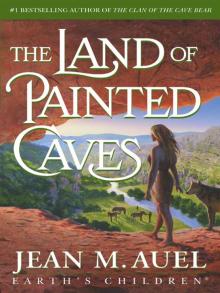 The Land of Painted Caves
The Land of Painted Caves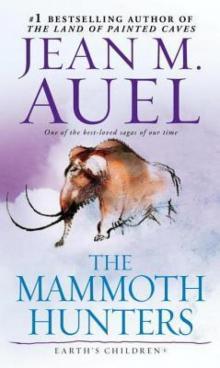 The Mammoth Hunters
The Mammoth Hunters The Earth's Children Series 6-Book Bundle
The Earth's Children Series 6-Book Bundle The Valley of Horses
The Valley of Horses The Shelters of Stone
The Shelters of Stone The Clan of the Cave Bear ec-1
The Clan of the Cave Bear ec-1 THE PLAINS OF PASSAGE ec-4
THE PLAINS OF PASSAGE ec-4 The Mammoth Hunters ec-3
The Mammoth Hunters ec-3 THE SHELTERS OF STONE ec-5
THE SHELTERS OF STONE ec-5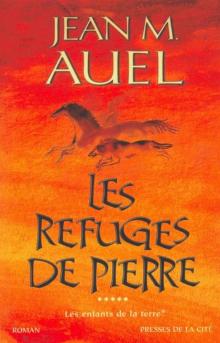 Les refuges de pierre
Les refuges de pierre![Earth's Children [02] The Valley of Horses Read online](http://i1.bookreadfree.com/i1/03/30/earths_children_02_the_valley_of_horses_preview.jpg) Earth's Children [02] The Valley of Horses
Earth's Children [02] The Valley of Horses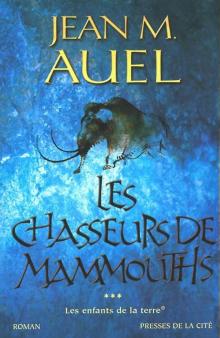 Les chasseurs de mammouths
Les chasseurs de mammouths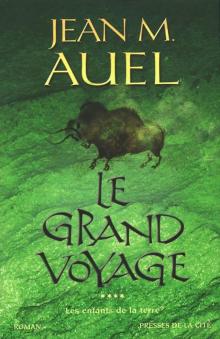 LE GRAND VOYAGE
LE GRAND VOYAGE The Land of Painted Caves ec-6
The Land of Painted Caves ec-6 The Valley Of Horses ec-2
The Valley Of Horses ec-2 La Vallée des chevaux
La Vallée des chevaux